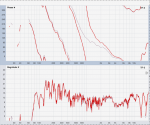Re: So this almost never happens...
Stuart,
I am not sure who is more the fool, the engineer who only listens or the engineer who only measures. I do not know any audio person who knows how to run a measurement system that does not run it in sympathy with their ears. One must play the strengths of each against the other... my ears tell me things I cannot measure, some subjective (should I add 3dB more HF boost?) and some objective (even though the MF measures flat, I need to kill 2.2kHz for this to sound balanced). The measurement system tells me things my ears cannot (there is a 30 degree phase lag between the LF and MF passband).
Stuart,
I am not sure who is more the fool, the engineer who only listens or the engineer who only measures. I do not know any audio person who knows how to run a measurement system that does not run it in sympathy with their ears. One must play the strengths of each against the other... my ears tell me things I cannot measure, some subjective (should I add 3dB more HF boost?) and some objective (even though the MF measures flat, I need to kill 2.2kHz for this to sound balanced). The measurement system tells me things my ears cannot (there is a 30 degree phase lag between the LF and MF passband).


